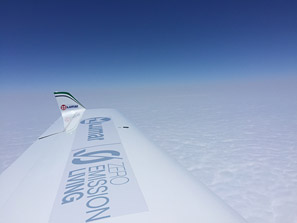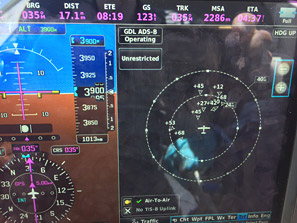From Nanning to Zhengshou - Matevž's impressions
The days in Nanning were truly stressful...

The days in Nanning were truly stressful. Firstly because of the ever changing weather, because of which no flight forecast stays accurate for more than a couple of hours, and secondly because of the process of getting permission to fly again. Siyu, the young man from the flight meeting's organisation board, takes care of all the documentation, but I sometimes feel like things are getting out of hand for him, although he is very quick when it comes to communication. He needs to speak to the military from all the areas ahead of me, the civil aviation administration (CAAC), and the ATC (flight control). Because this will be the first light aircraft to ever come to their meeting, it is still uncertain what will actually happen.
We postponed the takeoff by a day due to bad weather. I sent the young man radar recordings so he could argument and apologize for the delay. The Chinese do not yet understand that a 300kg plane cannot fly like the Boeing, because it is much more sensitive to weather conditions, does not have antifreeze treatment or a pressure cabin, and can only fly at the maximum altitude of 5000m, where the weather’s effects are the most intense. Such a plane also doesn’t have a weather radar or reliable instruments... Flying light aircrafts is still a very young discipline and will need a lot of time before the system can get used to this fact.
On Monday I was already in my plane first thing in the morning with a confirmed flight plan. The weather was decent enough for takeoff and most of my journey north. However, I didn’t get the permission to start my engine, because the aircraft control had yet not received permission from the military. When the arrangements were finally complete a few hours later, it was already too late because it would have gotten dark before I could reach the small airport of Shengjie, west of Zhengzhou, which has no lights or any other instruments for landing without any outside visibility. I returned to my hotel and hoped, that the weather in Nanning would not be as bad as they reported for the following day. The weather forecasts improved over the day, and at that point we were only waiting for the permissions.
I headed back to the airport again at night, only to receive bad news: Guiling’s military yet again denied my request for permission to depart, due to active military zones in my path. After hours of waiting, we received news that we were in the clear and allowed to proceed, but due to the delay the flight conditions at the airport worsened drastically. Horizontal visibility was 2000m and the clouds were at the altitude of 300m. Simply put, it was foggy. Despite these conditions I received permission for takeoff and the flight was very stressful all the way to Guiling, with clouds up to the height of 3000m. Due to interferences, communication was very bad and only sorted itself out after about two hours, when I was flying over the well-known karst cones near Guiling.
The hole in the clouds soon closed up and from then on I could no longer see China. I flew over a sea of clouds the entire time, at the altitude of 4000m, because that is what the military demanded for flight over their areas. In the second half of the flight a strong wind started blowing towards me and I had to follow a certain curved and twisted path between different military zones. Because of that the flight was extended to 8 hours. During descent the visibility once again dropped drastically so I had to spend the last 1,5h flying only using instruments. There are high hills south of Shengji, which is why I stayed at 2400m and started my unsure descent into the fog only right in front of the airport. The visibility on the ground was less than 3000 meter, and I only had coordinates of the airport. With the help of flight control I finally managed to find the runway, however it disappeared from my field of vision before the last turn before landing, so the controller had to direct me in the right direction.
The reception I received on the ground was huge and unexpected: water cannons, a number of reporters and cameramen. It seems like for them, the first arrival of a light aircraft is very important for the future evolution of aviation. Photographing followed, then getting the plane into hangar, getting into a car and driving to the Earthrounders’ meeting in Zhengzhou, which was an hour’s drive away.
Until next time, Matevž
Iz Nanninga v Zhengshou - Matevževi vtisi
Dnevi v Nanningu so bili res stresni. Najprej zaradi vremena, ki se spreminja iz ure v uro in nobena letalska napoved ne drži niti nekaj ur, drugo pa zaradi dovoljenja za letenje naprej. Siyu, mladenič iz organizacijskega odbora letalskega mitinga, ureja vse dokumente in včasih se mi že zdi, da mu stvari uhajajo iz rok, čeprav je zelo hiter v komunikaciji. Koordinirati mora med vojsko na celotni poti naprej, agencijo za civilno letalstvo CAAC ter ATC (kontrolo letenja). Ker je za njih to prvo lahko letalo, ki bo priletelo na miting, je vse precej negotovo, kaj se bo v resnici zgodilo.
Polet smo za en dan prestavili zaradi slabega vemena, zato sem mladeniču preko dneva pošiljal radarske posnetke, da je lahko argumentiral in opravičil zamudo. Kitajci še ne razumejo dobro, da 300 kg težko letalo ne more leteti enako kot Boeing, saj je bolj občutljivo za vreme in nima zdravila proti zaledenitvam, nima kabine pod pritiskom, leti lahko največ 5000m visoko, kjer se vreme najbolj intenzivno dogaja. Takšno letalo tudi nima vremenskega radarja, zanesljivih instrumentov.... Lahko letalstvo je še zelo v povojih in bo potrebno še veliko časa, da se bo celoten sistem temu prilagodil.
V ponedeljek sem bil že zgodaj v letalu s potrjenim planom leta in vreme je bilo solidno za odleti ter večino poti na sever. Dovoljenja za zagon motorja nisem dobil, ker kontrola ni prejela dovoljenja od vojske. Ko so čez nekaj ur uskladili med seboj, je bilo že prepozno, saj bi se stemnilo preden bi priletel na majhno namembno letališče Shengjie, zahodno od Zhengzhou, ki pa nima luči in inštrumentov za pristajanje brez zunanje vidljivosti.
Odpravil sem se nazaj v hotel in upal, da vreme naslednji dan v Nanningu ne bo tako slabo kot so napovedovali.
Vremenske napovedi čez dan so se izboljšale, čakali smo le še na dovoljenje.
Ponoči sem se zopet odpravil na letališče, novice pa slabe, ker vojska v Guilingu ponovno ni dovolila vzleta zaradi aktivnih vojaških zon v smeri letenja. Po negotovih urah čakanja, končo prispe novica, da so uredili dovoljenja, zamuda pa ja povzročila, da so se pogoji letenja na letališču zelo poslabšali. Horizontalna vidljivost je bila 2000m in oblaki na višini 300m, po domače bi temu rekli megla. Kljub temu sem dobil dovoljenje za vzlet in let je bil vse do Guilinga zelo stresen, v oblakih vse do višine 3000 m. Komunikacija je bila zaradi motenj zelo slaba in se je uredila šele čez kakšni dve uri, ko sem preletel znane kraške stožce v okolici Guilinga. Luknja v oblakih se je takoj zaprla in od tam naprej kitajske nisem več videl. Ves čas sem letel nad morjem oblakov, na višini 4000m, ker je tako zahtevala vojska za prelet njihovih območij. V drugi polovici je začel pihati močan nasprotni veter, slediti sem moral zaviti načrtovani poti med različnimi vojaškimi zonami. Zaradi tega se je polet podaljšal na 8 ur. Med spuščanjem je vidljivost ponovno izginila in zadnjo uro in pol sem moral leteti zgolj s pomočjo inštrumentov. Južno od Shengjie so visoki hribi, zato sem ostal na 2400m in šele pred letališčem začel negotov spust v meglo. Vidljivost na tleh je bila manj kot 3000 metrov, za lokacijo letališča pa sem imel samo koordinate. S pomočjo kontrole letenja sem končno našel pristajalno stezo, vendar mi je pred zadnjim zavojem pred pristankom zopet izginila iz vidnega polja in me je kontrolor moral usmerjati v pravo smer.
Sprejem na tleh je bil velik in nepričakovan, vodni topovi, številni novinarji, snemalci, ... Izgleda, da je za njiih prvi prilet tako majhnega letala res pomemben za nadaljni razvoj generalnega letalstva. Sledilo je še fotografiranje, letalo v hangar, potem pa v avto in na sprejem Earthrounder srečanja v uro oddaljen Zhengzhou.
Lep pozdrav do naslednjič, Matevž.












